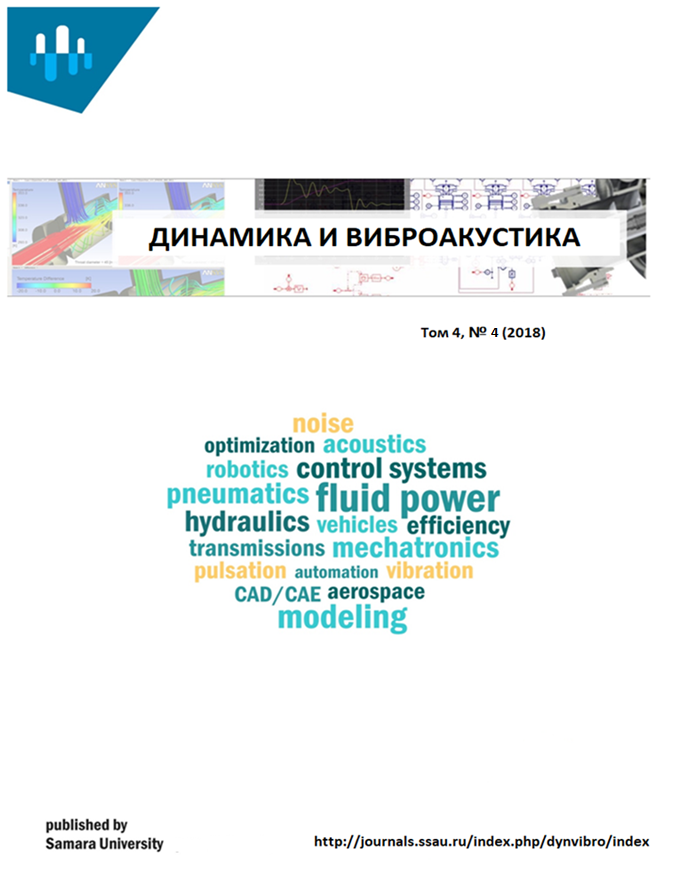Vol 4, No 4 (2018): 21.12.2018
- Year: 2018
- Published: 21.12.2018
- Articles: 5
- URL: https://dynvibro.ru/dynvibro/issue/view/356
-
Description:
опубликован 21.12.2018 г.
Full Issue
Articles
The influence of schlichting vortices on the absorption of sound by a solid surface
Abstract
The aim of this work is to study the mechanisms of acoustic energy dissipation due to the physical processes occurring in the acoustic boundary layer (APS), which occurs when the standing sound wave interacts with a solid surface. Unlike laminar APS in this case, in the wall layer of the medium, in addition to inhomogeneous viscous and thermal waves, acoustic Schlichting flows occur. Vortices can exist only due to the energy taken from the standing sound wave in consequence of which an additional mechanism of energy dissipation appears in the APS. A cylindrical tube with rigid walls, the ends of which are closed by impedance lids, was chosen as the object of research. When the longitudinal half-wave resonances are excited in the pipe, standing waves are excited in the pipe, formed due to the interaction of the normal zero-order sound waves running towards each other
 6-16
6-16


Planning of works to introduce the active noise and vibration control methods for shipbuilding
Abstract
The main provisions of the theory of active damping of noise and vibration are described using the adaptive suppression algorithm. Provides an overview of some successful foreign models of similar system used in various industries. Formulated the basic requirements for advanced system of active suppression, the creation of which will be in demand in shipbuilding.
 17-22
17-22


Suppression of wave instability in broad-area lasers by the external optical injection
Abstract
We theoretically investigate suppression of travelling wave instability in the transverse section of broad-area lasers. We investigate influence of the detuning between injected signal and generated radiation. The synchronization conditions were obtained under which the effective suppression of the wave instability occurs. Numerical simulation of the spatiotemporal dynamics of a broad-area laser with injection of external optical signal is carried out.
 23-26
23-26


Researches of processes of generation of sound waves by film thermophones
Abstract
This work is of a survey nature based on the results of studies of the processes of sound emission in gases and liquids by thermo-acoustic film sources - thermophones. The purpose of the article is to show the features of the calculation, operation and determination of the main acoustic characteristics of thermophones, ways to increase the efficiency of their radiation and directions of possible practical application.
The basic relations and formulas are presented, the calculation of which is confirmed by the experimental results carried out, analyzed ways to excite and improve the effectiveness of thermophones.
Film thermophones of various shapes without a thermally insulating substrate have uniform, reproducible acoustic characteristics, which can be predicted by calculation, knowing the thermal-physical constants of the materials used for the construction of thermophones. As the active elements of guns are used for a thin film formed by the vacuum deposition of metals on surfaces of bearing plates made of polymer materials. When passing through the active element of an alternating electric current with a frequency f, an acoustic wave is emitted at a doubled frequency of 2f. Film thermophone are the only sources of sound emitting surface which meets the definition of a piston radiator. Thermopane work in the frequency range from 1.0 to 150 kHz.
A promising direction of research is the use of thermophones as sources of radiation of sound in a liquid medium. The results of a study of the radiation of a film thermophone in two liquids (distilled water and kerosene) are presented. Compared to radiation to air, radiation to kerosene, for example, is about 20 dB higher.
 27-36
27-36


Free vibration frequencies of damped rotor mechanism
Abstract
The influence of the rotating rotor on the free vibration frequencies of the damped mechanism is considered. Under the assumption of absolute rigidity of both the body of the mechanism and its rotor, a system of differential equations for determining the free oscillation frequencies is obtained. The analysis of this system shows that the spectrum of natural frequencies is determined not only by the static characteristics of the mechanism (mass and moments of inertia) and its depreciation, but also by the speed of rotation of the rotor.
 37-41
37-41











